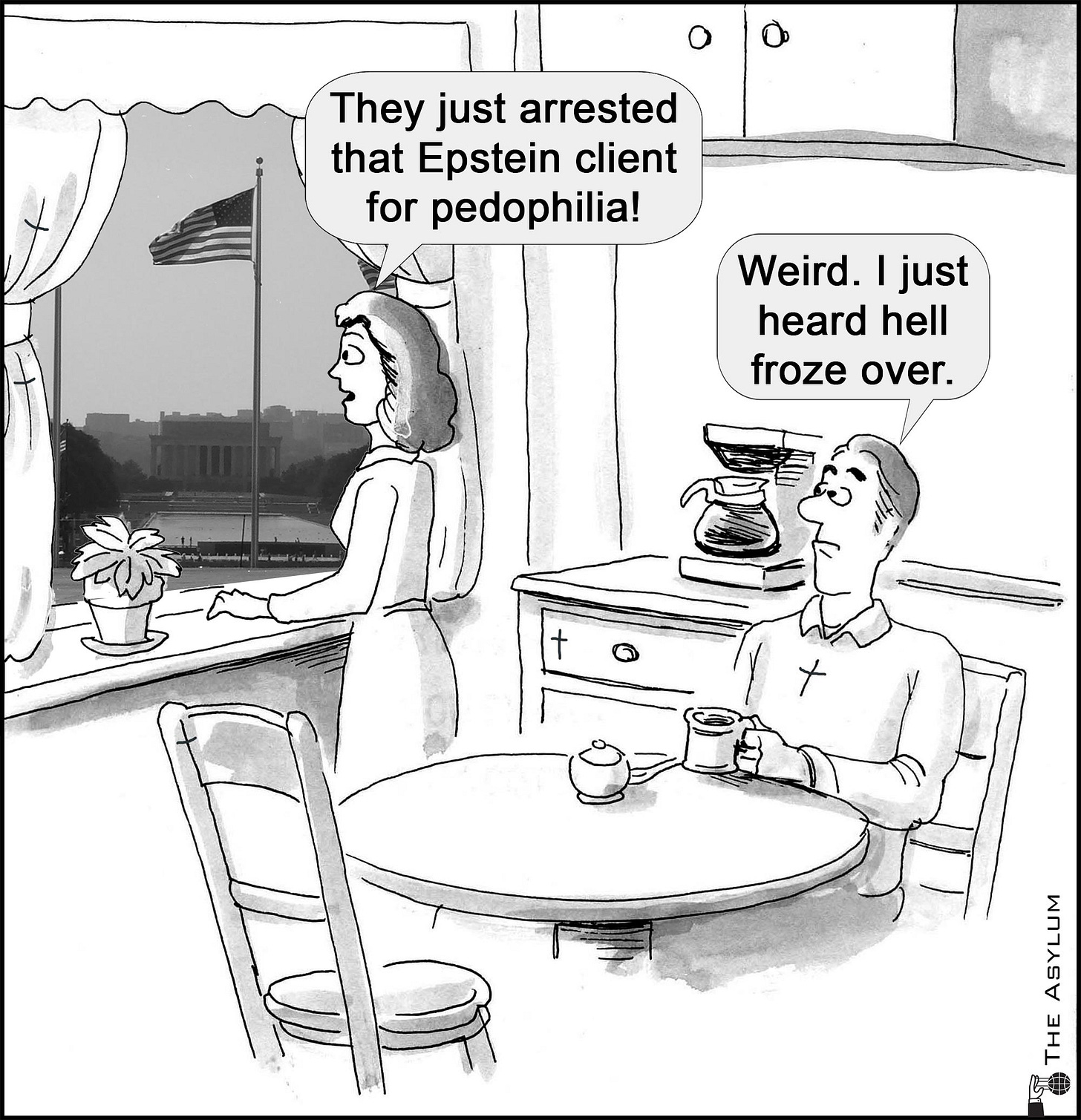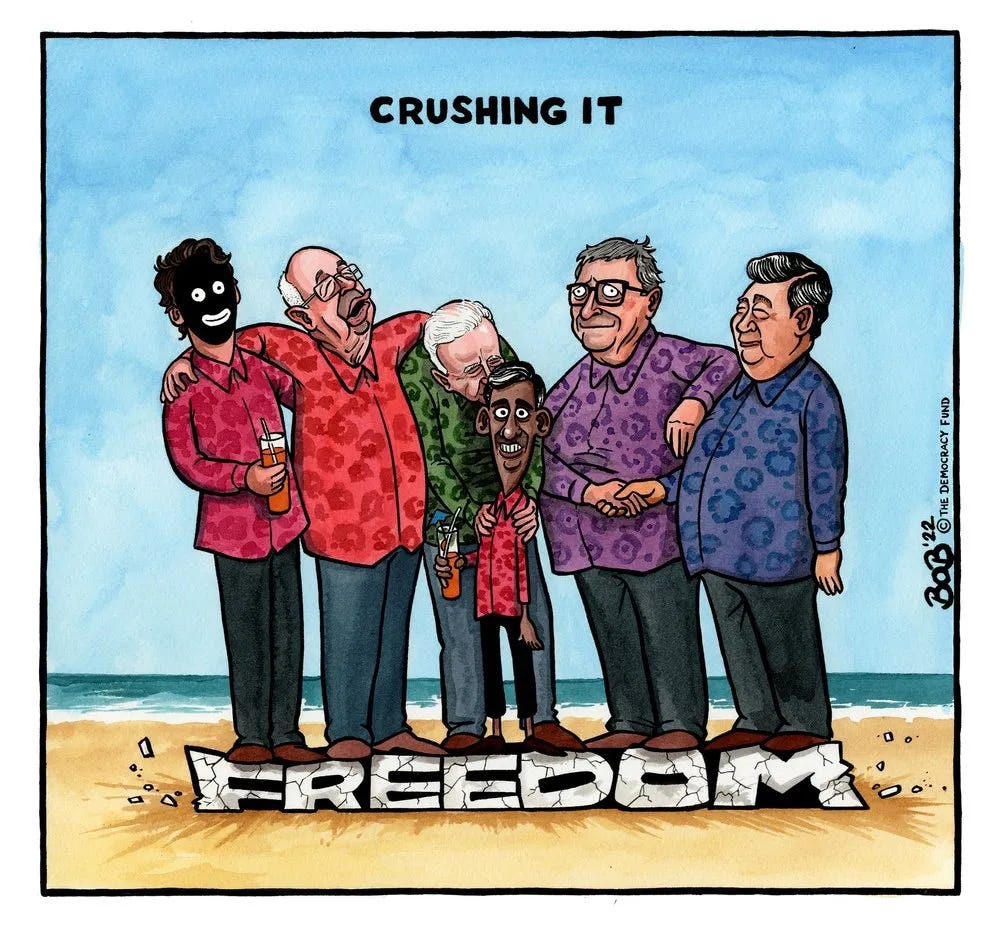A Symbol Plan: Marking Our Territory
"Symbols, don't forget, also represent territorial marks of ownership." — Daniel Estulin, Tavistock Institute: Social Engineering and the Masses
I’m reading the Tavistock Institute by Daniel Estulin. I plan to write a review when I’m done, but I just read a section where he spends some time writing about how the elites put their symbolism out there through music videos, music lyrics, movies, television, social media and even the acts of violence they commit. Most recently we’ve seen this in the Olympic opening ceremony in Paris and at the Emmy’s.
I’m sure others are doing this, but I’m going to start using our symbols in memes, cartoons and posters, sometimes hidden, sometimes overt, but there for all to see: symbols for Christianity and Freedom.
Along the way maybe I can mock the elites and their symbols…mock them for what they are: pathetic.
For satiric purposes, however, abuse has to be more than funny, it has to be damaging, and to be damaging it must strike us as really true.
Who are these elites really? They’re a cadre of morally bankrupt, totalitarian bullies who have neither the wisdom or genuine self-worth to live their own lives and leave the rest of us the hell alone. Without us nobodies, they’re nothing, because they don’t know how to live with themselves, don’t know how to be content without ruling others. Why would they want to depopulate the earth? What then will they do? Torment insects? Golf with robots? Kill each other? Do any of them have the ability to sit alone in a room?1 They appear to be nothing without a steady stream of sycophants worshipping at their feet with glazed expressions, microphones and cameras. It’s not a brave new world, it’s a grave new world where useful idiots worship useless, self-absorbed tyrants.
Question: What do you call an elite with a conscience?
Answer: Please ask a valid question.
Unfortunately, I suspect the elites would be happy to admit they have no conscience and no moral compass. In their world that’s a feature, not a bug.
Question: What do you call a Pharma executive with a conscience?
Answer: A whistleblower.
Bob Moran is great at mocking the elites and their agendas:
Spiritual War by Bob Moran. Used by permission. View or Buy Print.
Crushing It By Bob Moran. Used by permission. View or Buy Print.
I’m going to start marking our territory.
Here are some ideas for our symbols to use throughout our creative endeavors.
From ChatGPT (it has its uses):
Christian Symbols
Cross: The most universally recognized symbol of Christianity, representing the crucifixion of Jesus Christ.
Crucifix: A cross with the representation of Jesus’ body hanging on it, symbolizing His sacrifice.
Ichthys (Fish): An early Christian symbol representing Jesus. The Greek word for fish, “Ichthys,” is an acronym for “Jesus Christ, God’s Son, Savior.”
Alpha and Omega: These are the first and last letters of the Greek alphabet, symbolizing that God is the beginning and the end.
Chi-Rho: An early Christian symbol consisting of the first two letters of the Greek word for Christ.
Dove: Represents the Holy Spirit, as described in the story of Jesus’ baptism.
Lamb: Symbolizes Jesus as the “Lamb of God” who takes away the sins of the world.
Bread and Wine: Represent the body and blood of Christ, especially in the context of the Eucharist or Communion.
Anchor: Early Christians used this symbol to represent hope and steadfastness.
Candle/Light: Represents Jesus as the “Light of the World.”
Shepherd’s Staff: Symbolizes Jesus as the “Good Shepherd” who guides and protects His followers.
Crown of Thorns: Represents the suffering and sacrifice of Jesus.
Star of Bethlehem: Symbolizes the star that guided the Wise Men to the birthplace of Jesus.
Trinity Symbol (Triquetra): Represents the Holy Trinity – Father, Son, and Holy Spirit.
Freedom Symbols
Liberty Bell: An iconic symbol of American independence and freedom.
Statue of Liberty: A symbol of freedom, democracy, and hope.
Bald Eagle: Often associated with freedom and the strength of the United States.
Broken Chains: Represents liberation from oppression or slavery.
Open Handcuffs: Symbolizes release from captivity and freedom.
Dove: Often symbolizes peace and freedom.
Butterfly: Represents transformation and the freedom to change and grow.
Flag: Many national flags symbolize the freedom and independence of a country.
Freedom Bird (Eagle in Flight): Symbolizes the ability to soar freely and unrestrained.
Sunrise/Sunset: Often represents the dawn of a new beginning and the promise of freedom.
Torch: Represents enlightenment and freedom from ignorance.
Olive Branch: Symbolizes peace and freedom from conflict.
Tree: Represents growth, life, and the freedom to reach one’s potential.
Key: Symbolizes unlocking freedom and the ability to open new opportunities.
Phoenix: Represents rebirth, renewal, and the freedom to rise from the ashes of past struggles.
Notes
"I have often said that the sole cause of man’s unhappiness is that he does not know how to stay quietly in his room." — Blaise Pascal, Penseés, translated by A.J. Krailsheimer, Penguin Books, Harmondsworth, Middlesex, England, 1985, pg. 67.
This article also appears on my website, The Asylum. The website also has several things that are not possible to do on Substack: The World Economic Forum Members Reference (thanks to Dr. Malone), quotes, a large resources section, a robust search feature and some other things unique to the site: quizzes, word games and leaked communications.









Sadly, most often I am staying quietly in my room. It gets lonely sometimes.
I'd argue cheese should be listed among the symbols of freedom. Apart from being concentrated energy and concentrated enjoyment, cheese might have been the original currency. According to rat researchers, the first gold coins were made in the image of cheese rounds.
On a more serious note, this is an important discussion. Many of the symbols originally associated with freedom have now been defiled by totalitarian governments and movements, so it might be necessary to find some new ones. There's certainly demand for new symbolism if you consider e.g. the success story of Pepe.